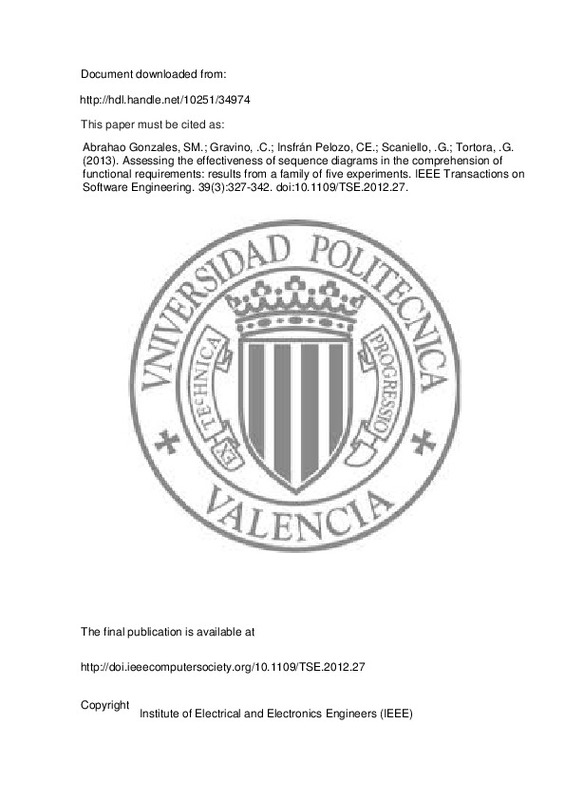JavaScript is disabled for your browser. Some features of this site may not work without it.
Buscar en RiuNet
Listar
Mi cuenta
Estadísticas
Ayuda RiuNet
Admin. UPV
Assessing the effectiveness of sequence diagrams in the comprehension of functional requirements: results from a family of five experiments
Mostrar el registro sencillo del ítem
Ficheros en el ítem
| dc.contributor.author | Abrahao Gonzales, Silvia Mara
|
es_ES |
| dc.contributor.author | Gravino, . Carmine
|
es_ES |
| dc.contributor.author | Insfrán Pelozo, César Emilio
|
es_ES |
| dc.contributor.author | Scaniello, . Giuseppe
|
es_ES |
| dc.contributor.author | Tortora, . Genoveffa
|
es_ES |
| dc.date.accessioned | 2014-01-20T13:38:49Z | |
| dc.date.issued | 2013-03 | |
| dc.identifier.issn | 0098-5589 | |
| dc.identifier.uri | http://hdl.handle.net/10251/34974 | |
| dc.description.abstract | Modeling is a fundamental activity within the requirements engineering process and concerns the construction of abstract descriptions of requirements that are amenable to interpretation and validation. The choice of a modeling technique is critical whenever it is necessary to discuss the interpretation and validation of requirements. This is particularly true in the case of functional requirements and stakeholders with divergent goals and different backgrounds and experience. This paper presents the results of a family of experiments conducted with students and professionals to investigate whether the comprehension of functional requirements is influenced by the use of dynamic models that are represented by means of the UML sequence diagrams. The family contains five experiments performed in different locations and with 112 participants of different abilities and levels of experience with UML. The results show that sequence diagrams improve the comprehension of the modeled functional requirements in the case of high ability and more experienced participants. | es_ES |
| dc.description.sponsorship | The authors wish to thank all the participants in the experiments. This research was partially supported by the MULTIPLE project (with ref. TIN2009-13838). | en_EN |
| dc.format.extent | 16 | es_ES |
| dc.language | Inglés | es_ES |
| dc.publisher | Institute of Electrical and Electronics Engineers (IEEE) | es_ES |
| dc.relation.ispartof | IEEE Transactions on Software Engineering | es_ES |
| dc.rights | Reserva de todos los derechos | es_ES |
| dc.subject | Documentation | es_ES |
| dc.subject | Requirements specifications | es_ES |
| dc.subject | Software engineering | es_ES |
| dc.subject.classification | LENGUAJES Y SISTEMAS INFORMATICOS | es_ES |
| dc.title | Assessing the effectiveness of sequence diagrams in the comprehension of functional requirements: results from a family of five experiments | es_ES |
| dc.type | Artículo | es_ES |
| dc.embargo.lift | 10000-01-01 | |
| dc.embargo.terms | forever | es_ES |
| dc.identifier.doi | 10.1109/TSE.2012.27 | |
| dc.relation.projectID | info:eu-repo/grantAgreement/MICINN//TIN2009-13838/ES/Multimodeling Approach For Quality-Aware Software Product Lines/ | es_ES |
| dc.rights.accessRights | Abierto | es_ES |
| dc.contributor.affiliation | Universitat Politècnica de València. Departamento de Sistemas Informáticos y Computación - Departament de Sistemes Informàtics i Computació | es_ES |
| dc.description.bibliographicCitation | Abrahao Gonzales, SM.; Gravino, .C.; Insfrán Pelozo, CE.; Scaniello, .G.; Tortora, .G. (2013). Assessing the effectiveness of sequence diagrams in the comprehension of functional requirements: results from a family of five experiments. IEEE Transactions on Software Engineering. 39(3):327-342. https://doi.org/10.1109/TSE.2012.27 | es_ES |
| dc.description.accrualMethod | S | es_ES |
| dc.relation.publisherversion | http://doi.ieeecomputersociety.org/10.1109/TSE.2012.27 | es_ES |
| dc.description.upvformatpinicio | 327 | es_ES |
| dc.description.upvformatpfin | 342 | es_ES |
| dc.type.version | info:eu-repo/semantics/publishedVersion | es_ES |
| dc.description.volume | 39 | es_ES |
| dc.description.issue | 3 | es_ES |
| dc.relation.senia | 237414 | |
| dc.contributor.funder | Ministerio de Ciencia e Innovación | es_ES |







![[Cerrado]](/themes/UPV/images/candado.png)

